Running a regular team retrospective is a must if you want your team to improve and grow. And it’s twice as important if you’re leading a large distributed team.
A retrospective meeting is a fine opportunity for the whole team to get together, uncover any problematic issues, and have an open discussion about how to work better together in the future.
As Slido’s Head of Customer Care team (currently 24 people strong, spread across 10 countries and 5 time zones), I can’t imagine a more effective way to iron out any issues that might occur and make sure everyone’s rowing in the same direction.
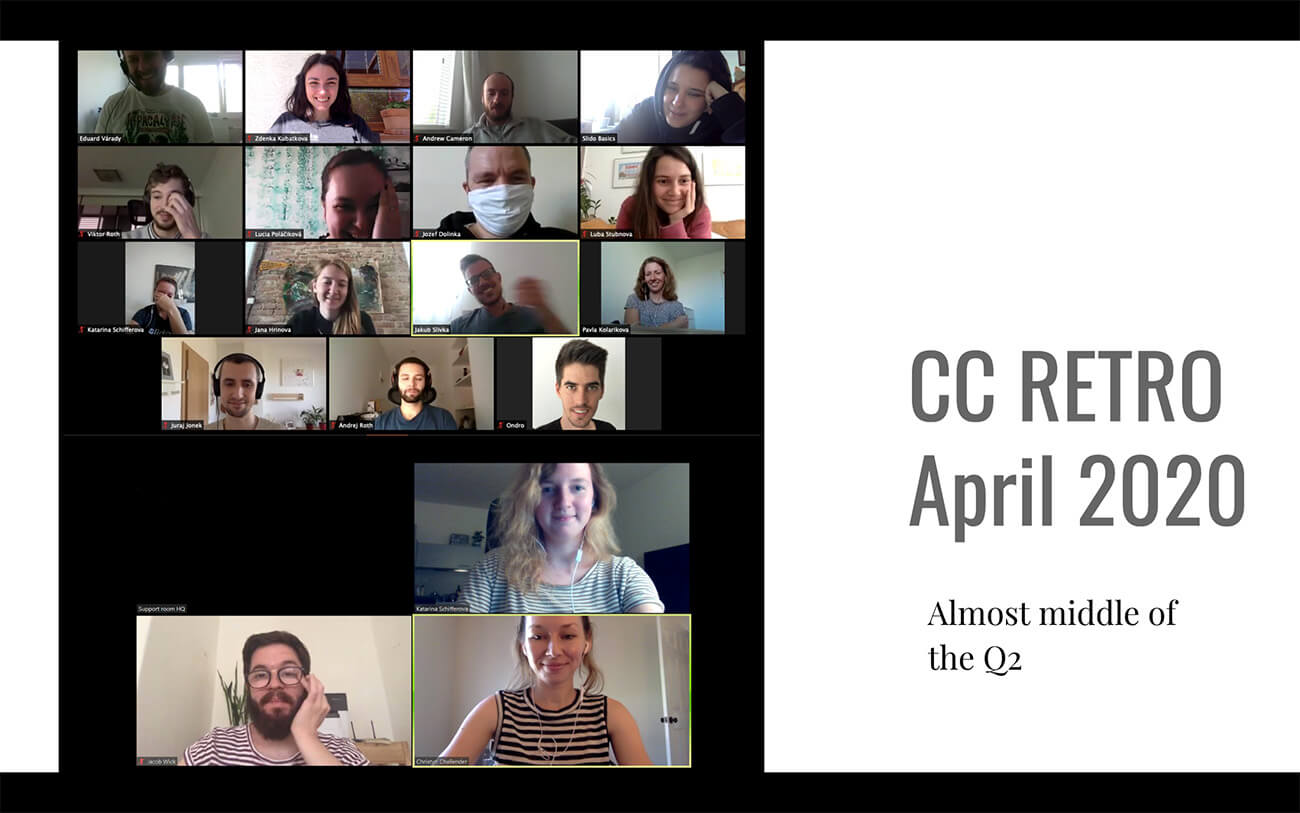
Today, I’d like to share with you my 9 best practices that help me run effective team retrospectives with our distributed 20+ customer care team.
But first:
What is a team retrospective?
A team retrospective, or ‘retro’ for short, is a meeting typically held at the end of a project or a season, aimed at identifying what worked well, what did not so well, and uncovering problem areas that the whole team can learn from and fix.
This format originates in the Scrum framework, where sprint retrospectives are part of the workflow.
Retrospectives are popular with various teams who run them to reflect on past successes and failures and to agree on what’s to be improved.
How to run effective retrospectives remotely?
Yes, running retros via video conferencing is challenging. Especially for a large distributed team.
Ever since Covid hit and we became fully remote, we had to rethink our retrospectives in a way that they would not only meet the meeting objectives but also give everyone an equal voice in a discussion.
Here are 9 game changers that perked up our remote team retrospectives.
#1. Make retrospectives a tradition
As a manager leading a large remote team, you need as many opportunities to discuss things with your team as possible.
Include retrospectives in your regular team agenda, with a frequency that makes the most sense for you and your team. For instance, in our Customer Care team, we run retros every 6 weeks – at the end of each quarter and halfway through the quarter.
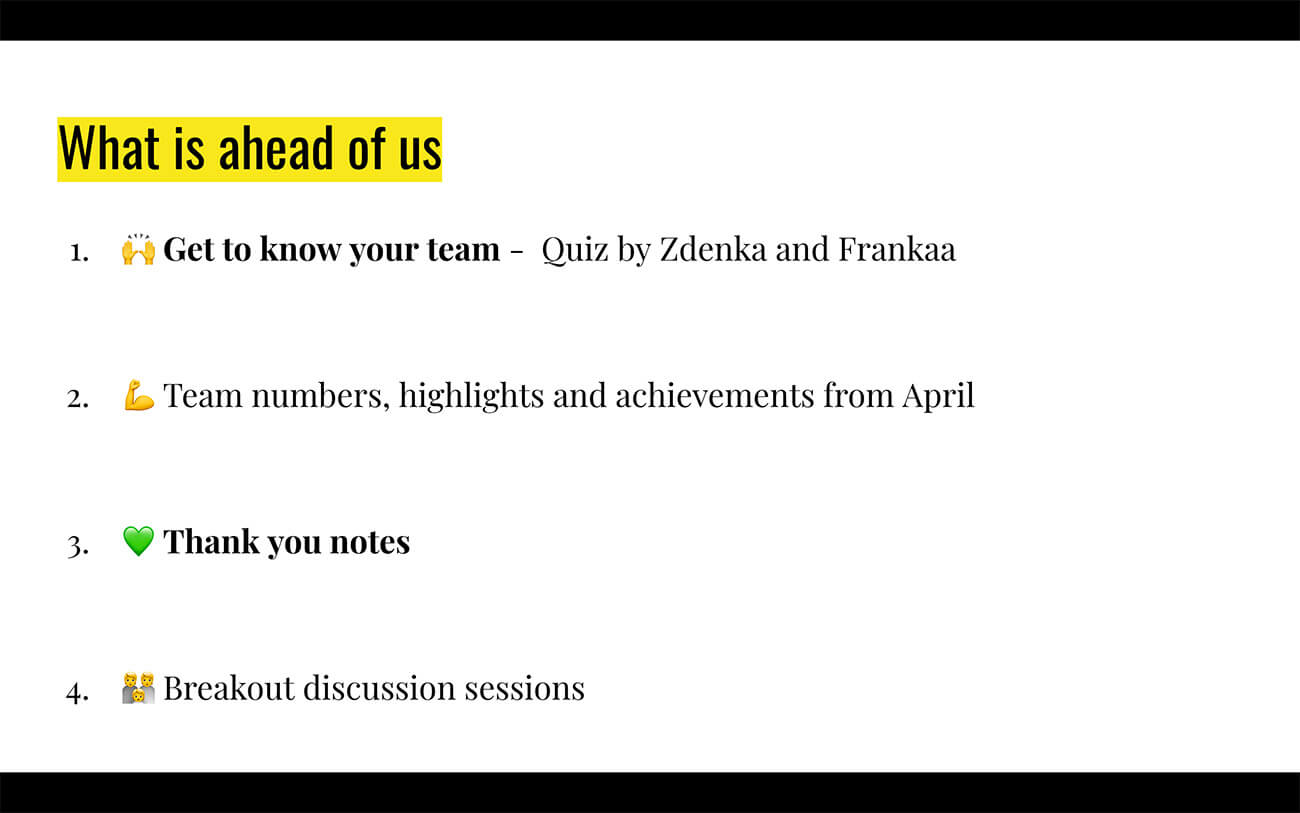
I put placeholders in our teammates’ calendars well in advance so they can better prepare for the retrospective and think about things they want to discuss.
#2. Involve everyone actively from the start
With 20+ people on the call, it is easy for anyone to “hide” behind a turned-off camera or a muted microphone. Don’t let your team fall into a passive state — activate them from the very beginning.
First, motivate people to turn on their cameras – it’s always nice to see each others’ faces.
Second, kick off your meeting with an interactive activity that will compel everyone to actively contribute to the meeting.
I often start a meeting with an interactive poll.
For instance, I ask my team something like: “How’s September treating you so far?” I often make it a rating poll, to run a quick pulse check on how the team is feeling.
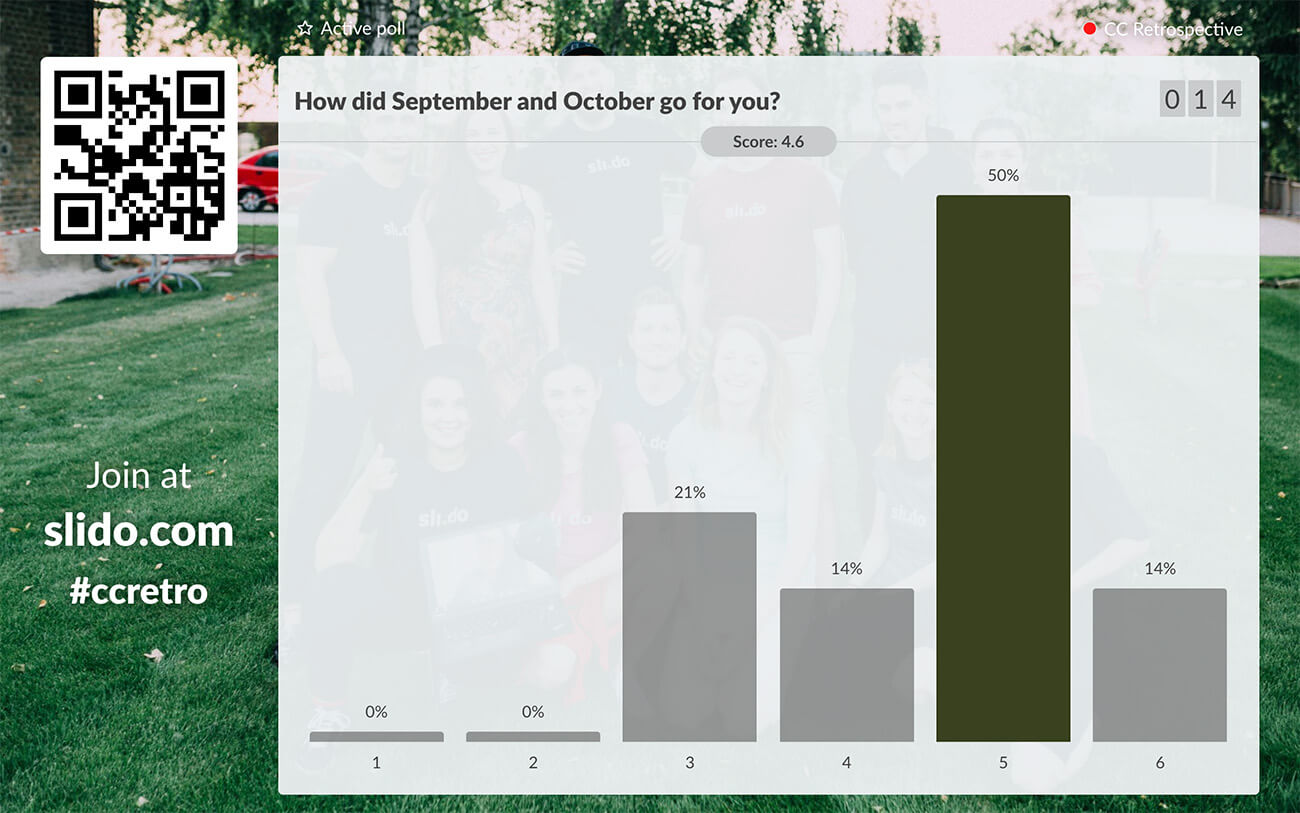
Or, you can do a word cloud, asking your team: “How would you describe September in one word?”
The important thing is to follow up on the answers your team has given in the poll. I always encourage a short discussion afterward by saying, “Would anyone like to share how they voted, and why?” Also, I try to involve the less vocal people in the team by calling out on them directly.
#3. Run stop-start-continue in breakout sessions
After we recapitulate stats and numbers from the season, we do a stop-start-continue round.
For those of you not familiar with the stop-start-continue concept, it’s a classic retrospective method that helps teams improve thanks to identifying things they should stop doing, start doing, or continue to do the way they were done before in order to reach success.
Since we’re a 20+ team, we do stop-start-continue in breakout sessions.
We split into groups of 5-6 people. Each group has 20 minutes to discuss things we should stop, start, or continue doing.
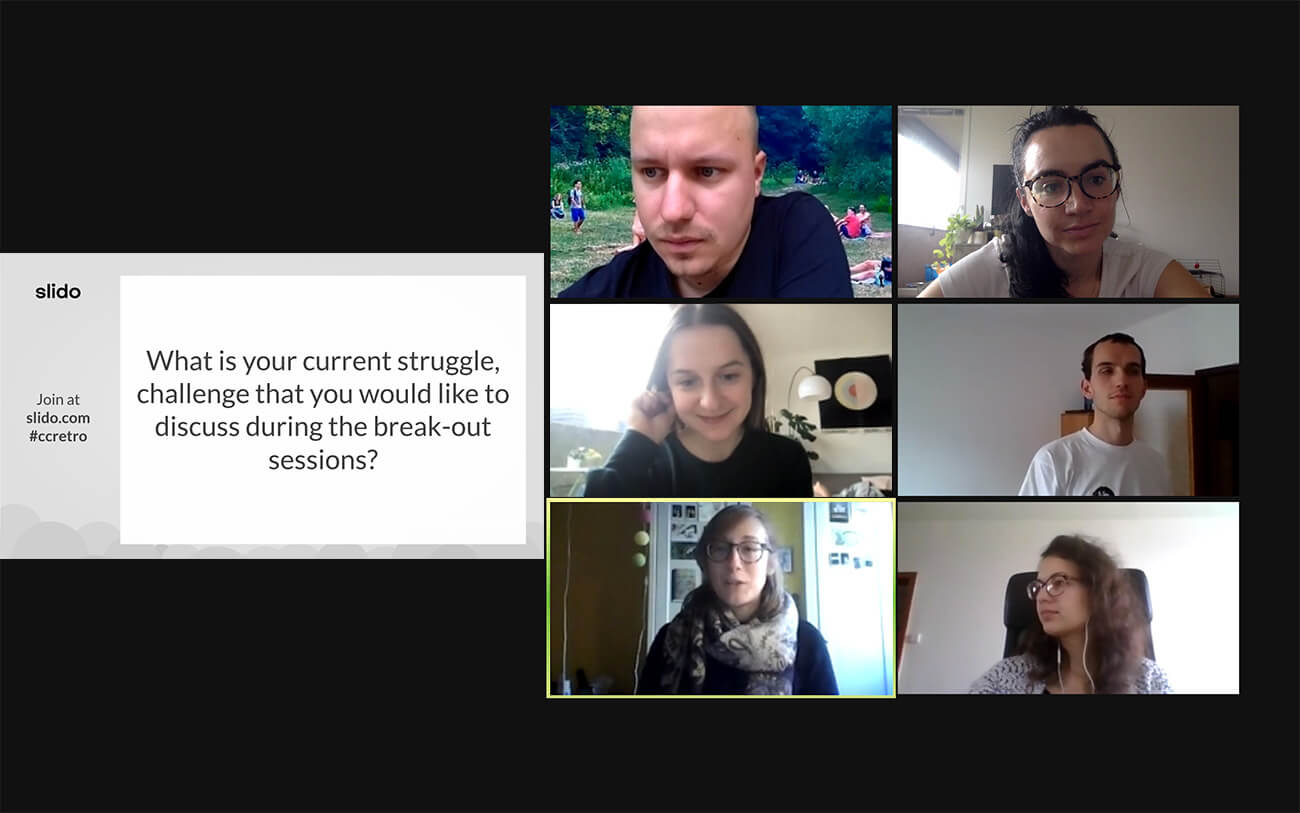
After the discussions, I asked each group to post their outputs in a Slido survey:
- Is there anything we should stop doing?
- What things should we start doing?
- What should we continue doing as before?
Doing retrospectives in this way is effective for two main reasons:
One: If people discuss first, then write down their thoughts as a group, it gives us more condensed and relevant insights.
Two: Breakout sessions are refreshing – people have the space to talk to their colleagues and be active – as opposed to just passively listening to what’s happening on the call.
#4. Share the outputs and have an open discussion
Once people have finished discussing, and each group has submitted their outputs into Slido, we get back together and review the results from the survey together.
I share the answers on the screen, we go through what each group has posted, and then we run three rounds of discussions (one for each of the questions).
In order to get to the bottom of things and help the discussion flow, I always try to follow up on what people have written and encourage them to share the reason behind their answers.
For example, I ask: “Which group has posted this? Can any one of you please elaborate?” Or, “Okay, this seems to be a recurring issue. Does anyone have any idea why we keep struggling with this?” It’s also good to ask people to propose concrete steps for improvement.
Finally, to honor an open discussion, I always keep Slido Q&A open and encourage people to post questions they might have about what we’ve talked about. I review them as they come in and try to incorporate them into the ongoing discussions.
#5. Make decisions and agree on the next steps
Make sure the ideas you’ve discussed throughout the meeting are turned into actionable next steps. This is especially important for ‘stop’ and ‘start’ parts.
During each discussion round, we try to agree on a concrete thing or multiple things that we will stop or start doing based on what people have submitted.
Sometimes, discussions uncover the next step that the whole team seems to be on board with. Just to be sure that everyone is happy with the decision, I run a quick Yes/No poll such as: “Are you happy for our team to start doing X?”
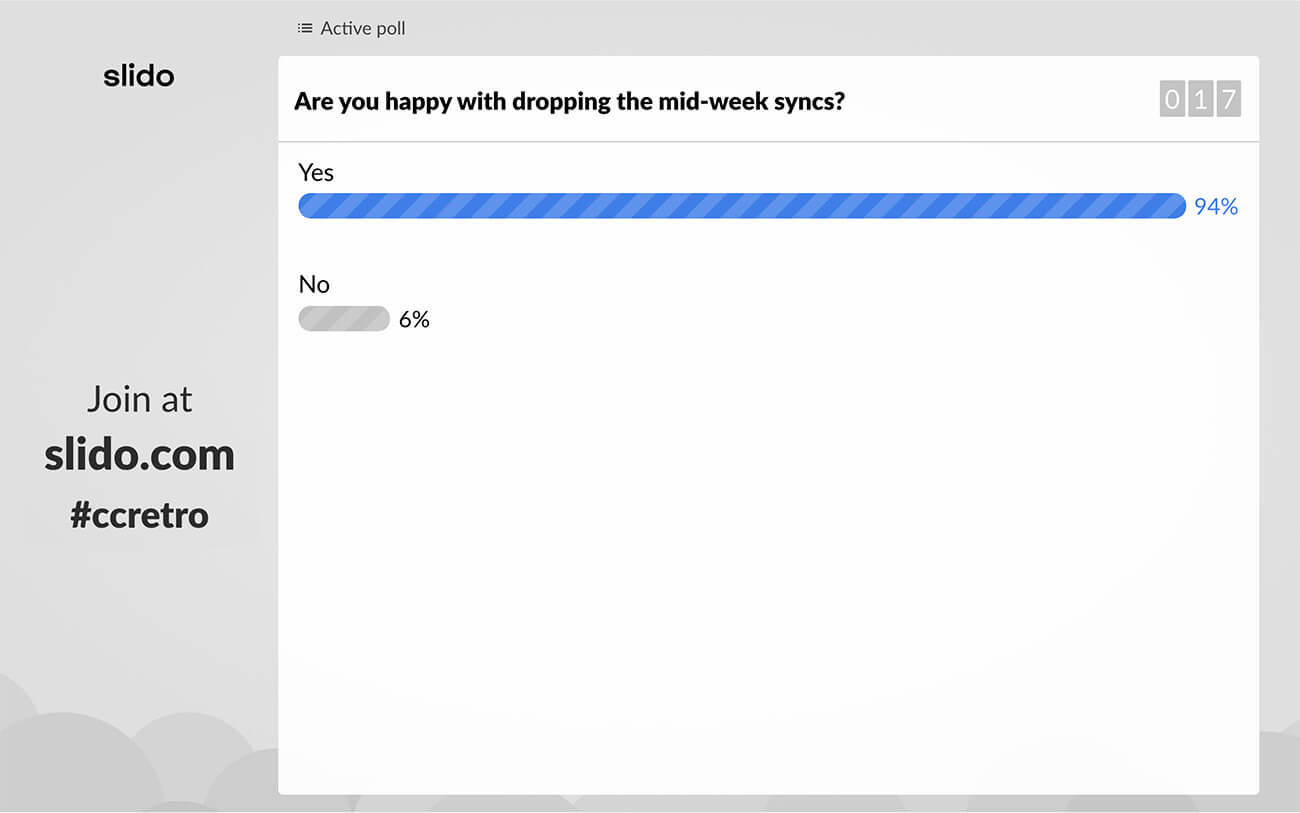
On other occasions, the discussions bring forth several burning issues, in which case we have to prioritize. Polls will help you here as well.
If, for example, your team proposed several great new ideas for your team to start doing, put them into a multiple choice poll, and let your team vote for their preferred one/s.
Read also: Team Decision Made Easy
#6. Focus on positive reinforcement
Retrospective sessions sometimes tend to get a little negative. People often switch into a criticizing mode and focus merely on things that didn’t or don’t work. This can easily leave a bitter taste in your mouth as you leave the meeting.
That’s why I always weave into our retrospective meetings some activities that reinforce positivity and team cohesion. Retros are, after all, also great opportunities to meet and get to know each other better – especially since we’re a remote team.
For instance, we recently ran a ‘Get to know your team’ quiz at the start of the retro.
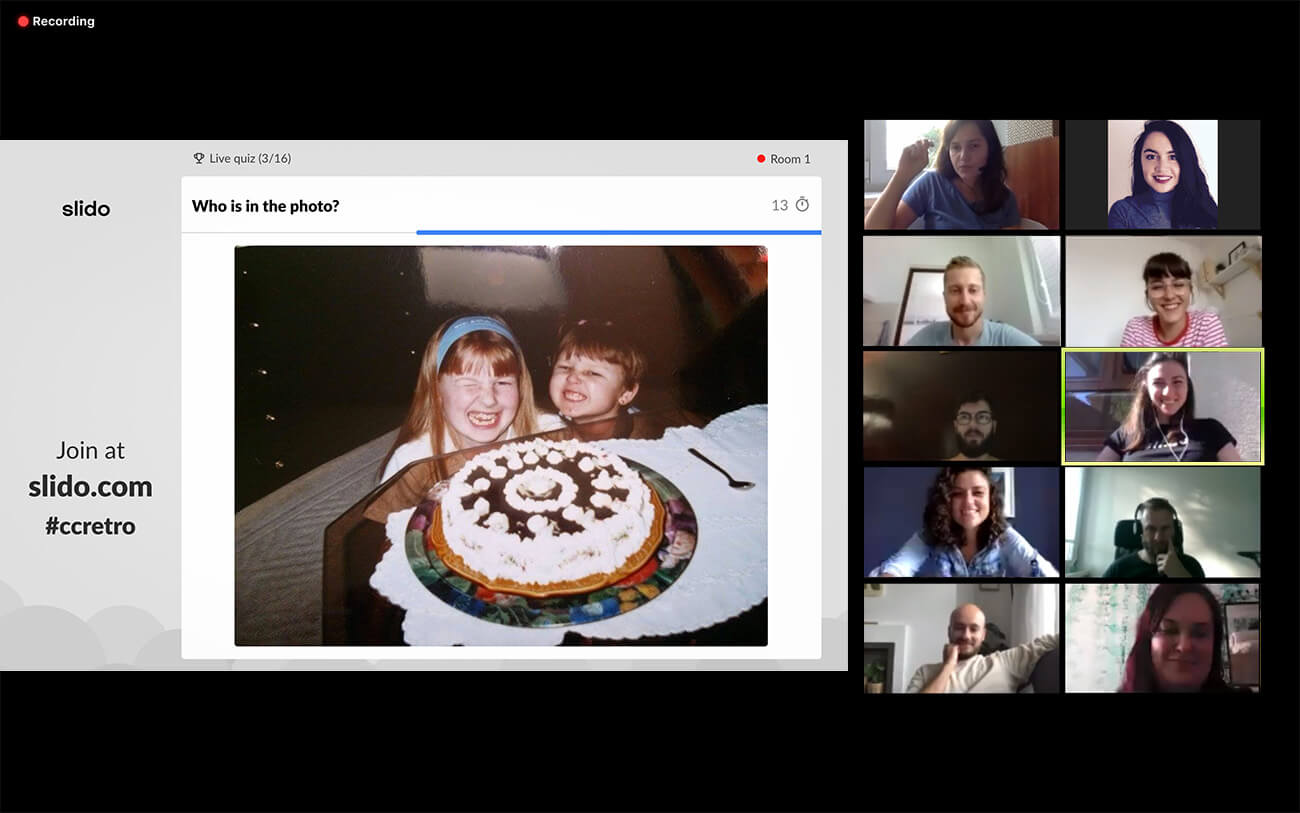
Our two colleagues prepared a series of quiz questions about our teammates with some fun facts and let others guess away. It was so much fun and really set a positive mood for the rest of the meeting.
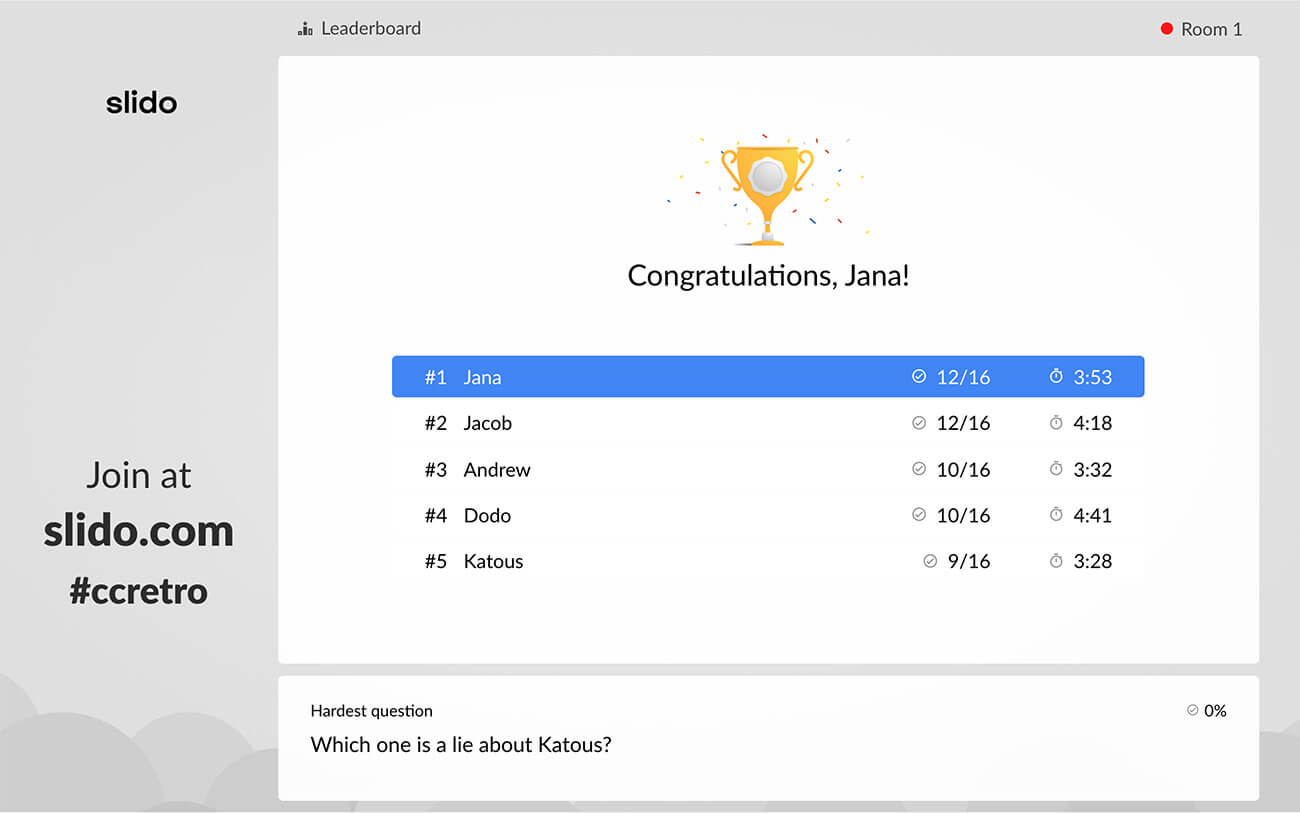
Another time, I asked each teammate before the meeting to send me their favorite photo of last month. I then prepared a couple of slides with people’s photos, showed them during the meeting, and encouraged people to share a story behind the picture.
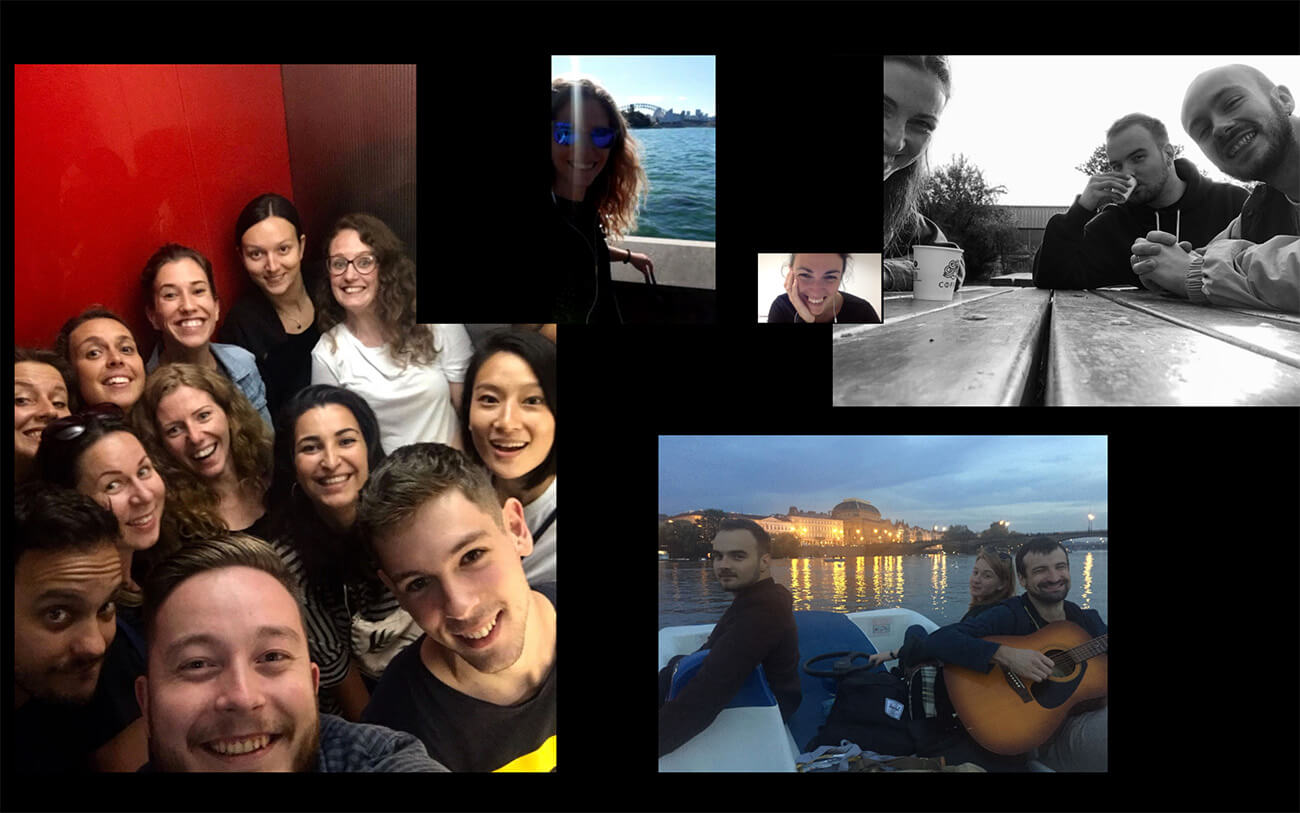
Read also: The Complete List of 200 Icebreaker Questions For Meetings and Tips On How to Use Them
#7. Celebrate people and their achievements
Another way to promote positivity during your team retrospective is acknowledging people’s hard work and celebrating all the good things they helped achieve.
One of my favorite morale boosters that we often do during our customer care team retrospective is running a poll: “Who would you like to thank/praise and why?”
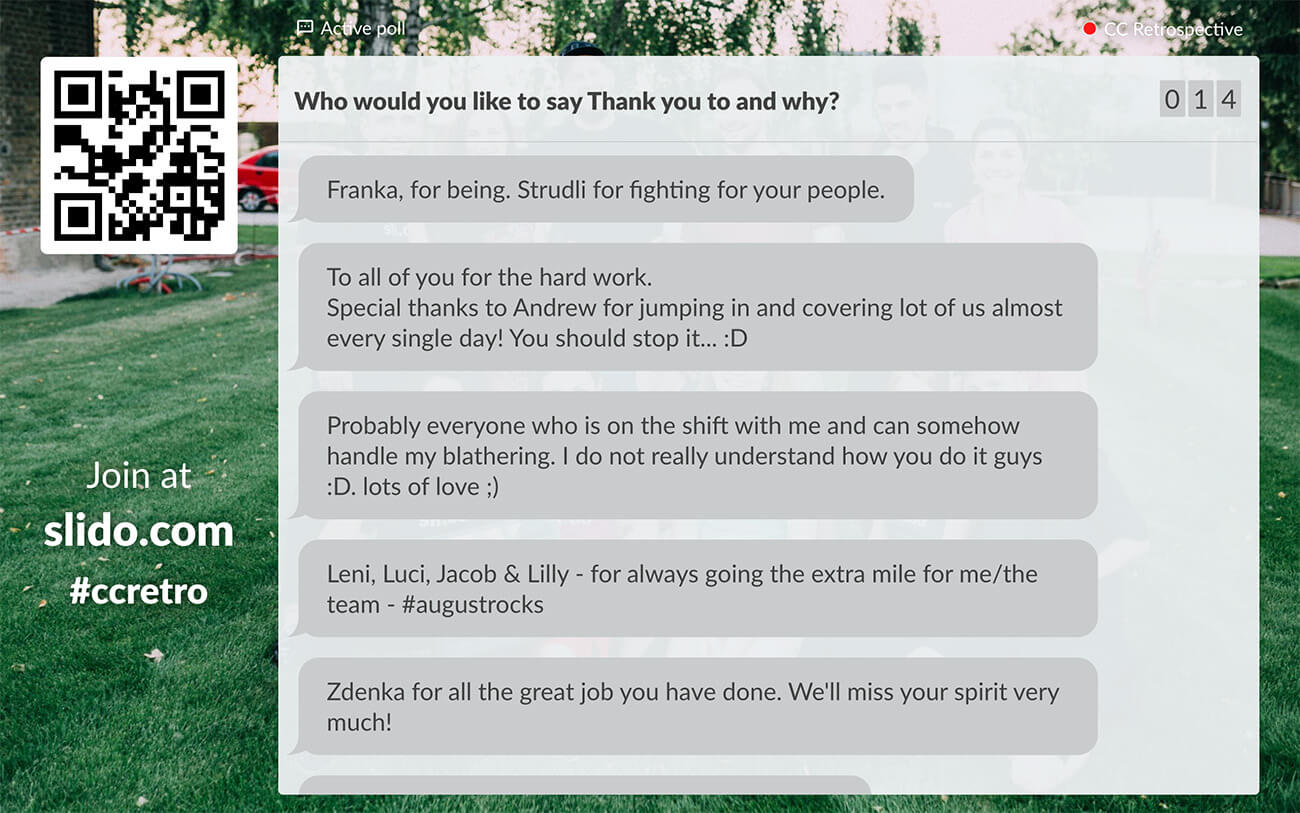
We do a word cloud poll where people can write the name of the person who they’d like to thank and an open text poll where they can write a comment as to why they’d like to thank them.
Teammates giving a public shoutout to other teammates is very powerful: it really lifts people up and strengthens the team spirit.
Another activity I like to do is ‘highlights sharing’. I run an open text poll where I ask people: “What was your personal highlight of the last 6 weeks?” I prompt teammates to submit anything good that has happened to them, either at work or in their personal lives.
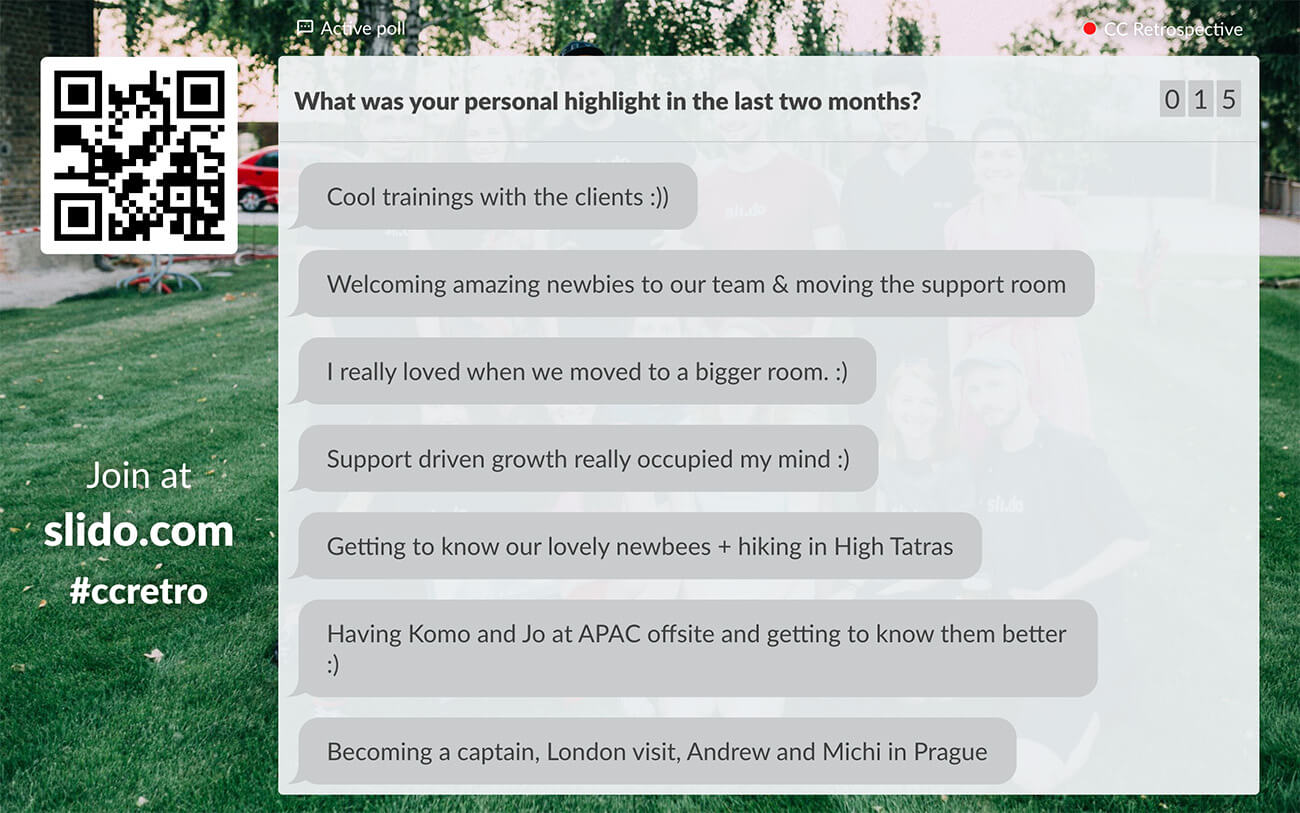
We then look at what people have written, and I encourage volunteers to share stories behind their favorite moments. It’s really heartwarming and makes the meeting more personal.
#8: Don’t forget about those who cannot join in person
If your team is scattered around the world, chances are there will always be some people who won’t be able to make it to the call in person. Being spread from APAC to the Americas, it’s certainly like that for us.
I do a couple of things to make sure everybody feels involved. First, we rotate the times of the retrospectives: One time in APAC-friendly hours, another time in US-friendly hours.
Also, I always collect inputs from those who won’t be able to join in advance via Slido. I ask them to fill out the stop-start-continue survey as well as other polls that we run during the meeting. This way, we can include their thoughts and ideas in the meeting so they feel heard and acknowledged once they watch the recording later.
This brings me to the next point – always record the meeting and share the recording with everyone on the team. We even have a separate folder in Google Drive with all the meeting recordings where people can easily find them and re-watch them whenever they need.
#9: Leave nothing to chance: Think of all interactions in advance
If you want to design a truly interactive team retrospective meeting, think of all the points of interaction as you prepare slides for your meeting.
Go through your flow and think about where you could insert a poll, or a discussion round to re-engage your teammates and encourage them to actively contribute.
My secret weapons are our integrations: Slido for Google Slides and Slido for PowerPoint which allow me to add a Slido poll, quiz, or Q&A directly to my slide deck.
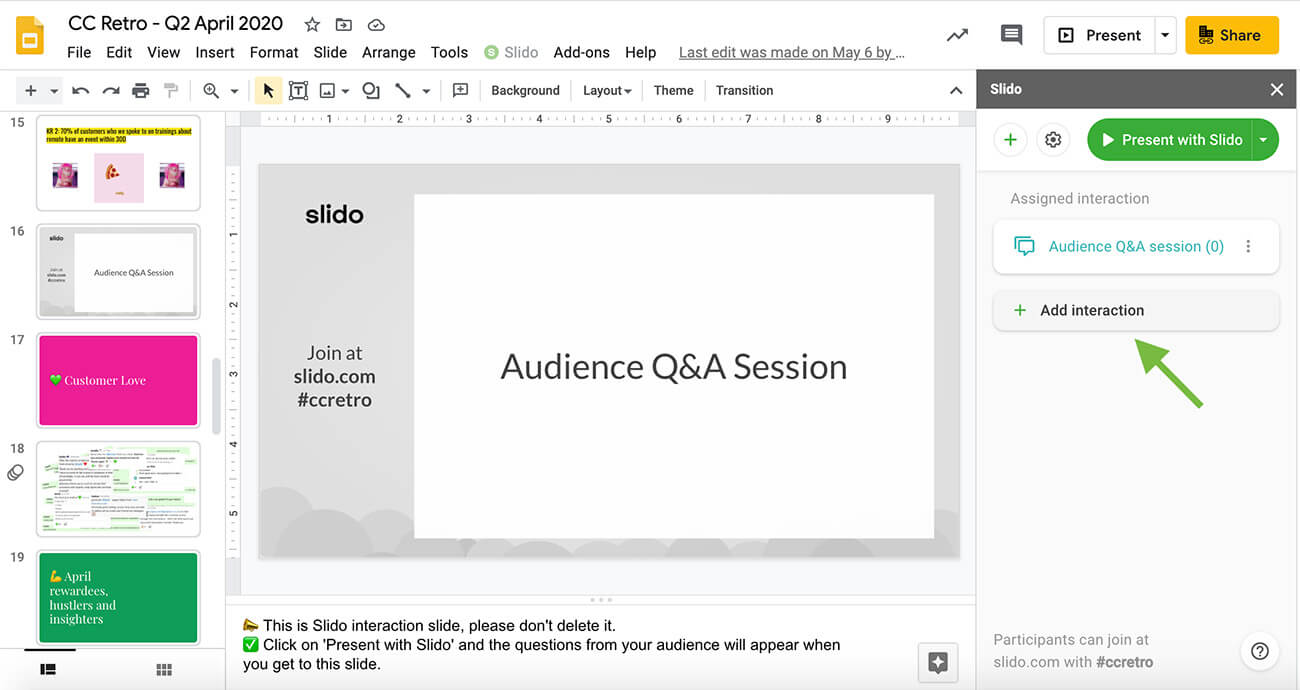
Each Slido interaction is added as a separate interactive slide – and I can manage everything just as I click through the slides.
This makes it so much easier for me to design a meeting that’s interactive, inclusive, and engaging. Plus, since I have all the interaction as part of the slideshow, I never forget to interact with my teammates.
Wrap up
Running a team retrospective via videoconferencing is no small feat, but do it well and it’ll help your team work together better and grow both professionally and personally.
The key is to give your teammates a voice and make them an active part of the meeting – because you’re not doing retrospectives for your team, but rather with your team.
I hope that the above tips will help you make your retrospectives more interactive, productive, and engaging for your teammates.
For the easiest interaction with your colleagues, try our Google Slides or PowerPoint integration (see point 9) which will allow you to add live polls, quizzes, or Q&A directly to your slide deck.
I’m sure it’ll help you make the most of your sessions and bring more meaningful conversations to your meetings. Good luck!




